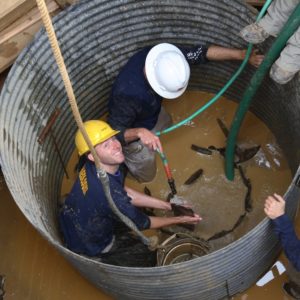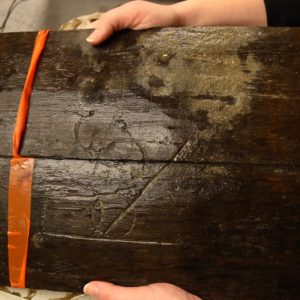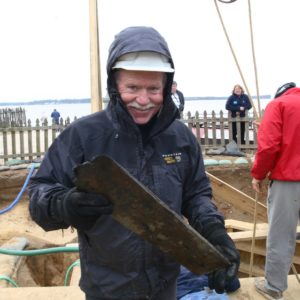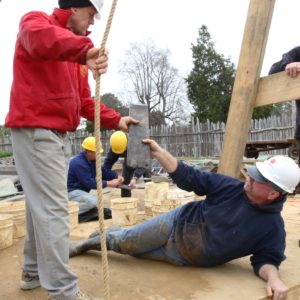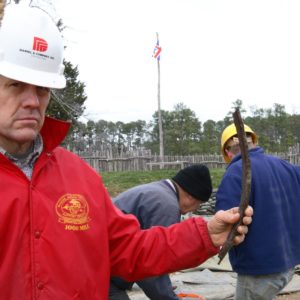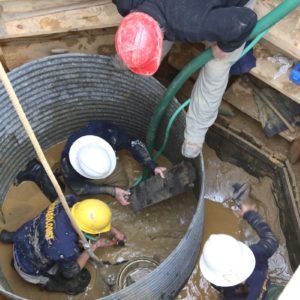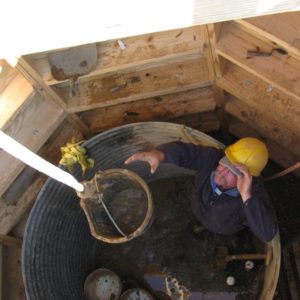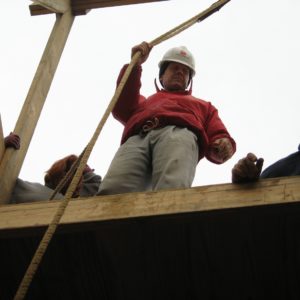The Jamestown Rediscovery archaeological team has concluded its excavations of an early well at the center of James Fort. A wooden barrel was found at the bottom, used by the colonists to keep the well’s clay walls from collapsing and choking off the water supply. While the upper layers of the well provided no shortage of artifacts, there was remarkably little at the bottom, perhaps suggesting that there was regulated access to the water source and less chance for accidentally dropping something inside.
Fourteen feet below the surface the archaeologists have reached the bottom of what was most likely the fort’s first well, built in 1609 under the direction of Captain John Smith. Underneath the barrel, several large cobbles were discovered that probably served as its foundation. Some of the cobbles are partially encrusted with barnacles, suggesting that they ballasted a ship during the journey from England. Analysis of the cobbles is planned which will hopefully tell us if they are of European or American origin. The barrel itself was removed one stave at a time and then labeled with a ribbon and placed back underwater in a tank in the conservation lab. Haste was made in resubmerging the barrel staves as the 400-year-old wood would quickly decay when exposed to the air after having been underwater for four centuries. Portions of the wooden hoops holding the barrel together were found as well, as was the bung which plugged the barrel’s bunghole when it was used to store liquids.
In an attempt to make the excavations more effective, three pumps were used to remove water from the well. It was a constant struggle as digging below the water table meant a never-ending seeping-in of water from the well’s super-saturated clay walls. A metal casing was also placed in the well in an attempt to isolate the barrel excavation area and get some relief from the water rushing in. All of these efforts met with varied success and the excavators experienced only momentary dry spells. Luckily, the water was much warmer than the December air above. The archaeologists used a high-pressure water nozzle to loosen up the clay surrounding the barrel so that it could be excavated.
In addition to the barrel itself, a few other artifacts were found during the last day of excavation. Several fragments of wooden cask hoops were pulled from the bottom of the well as was a hickory nut and a sweet gum ball. A musket ball and a lead runner from the production of musket balls were also found. The small number of artifacts found in the bottom of the well is unusual when compared to previous wells excavated in and around the fort. This well is directly adjacent to the storehouse at the fort’s center. Archaeological evidence suggests that this well may have been housed in a covered addition to the storehouse and access to it may have been regulated as access to the storehouse was. Less access would have meant less chance for the accidental dropping of items down the well. This is one theory for the scarcity of artifacts at the very lowest sections of the well.
The Jamestown Rediscovery team now heads indoors to write reports on this year’s dig. The conservation staff has plenty of artifacts to keep them busy until spring arrives and the archaeologists head back out to the fort.
related images
- The dark wood of the barrel can be seen at center
- Barrel stave with markings
- Director of Research and Interpretation William Kelso holds one of the recently-excavated barrel staves
- Archaeologists Don Warmke and Dan Smith with one of the barrel staves. The staves were immediately resubmerged in water to prevent deterioration.
- Archaeologist Don Warmke holds a segment of one of the barrel hoops
- The final day of the well excavations
- Archaeologist Dan Smith sends a bucket up out of the mud
- Removing the barrel



